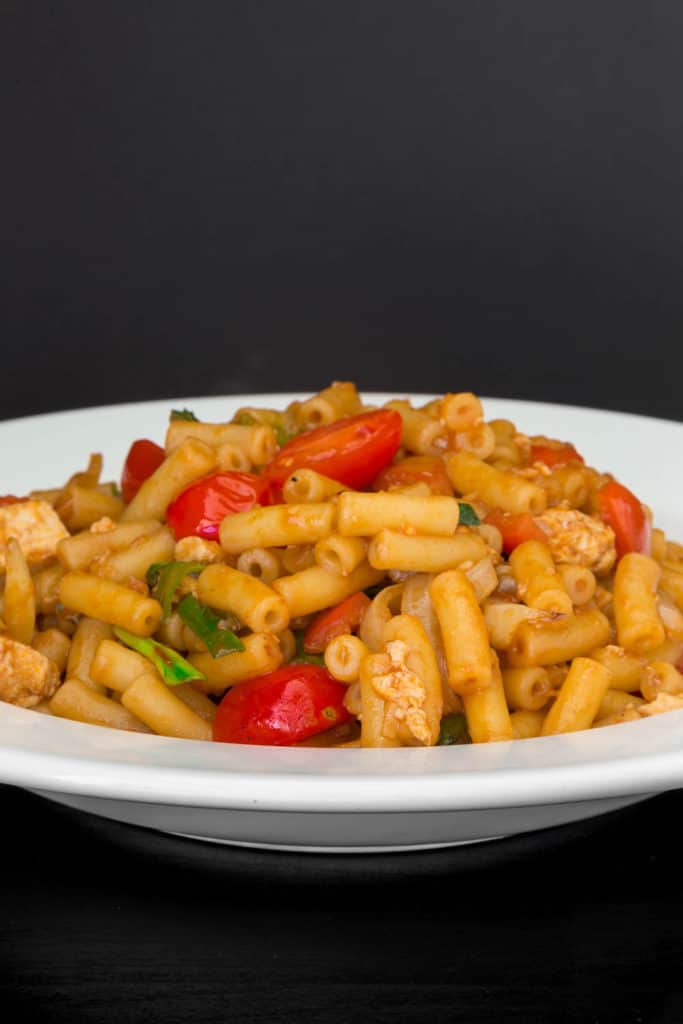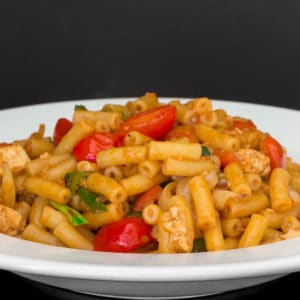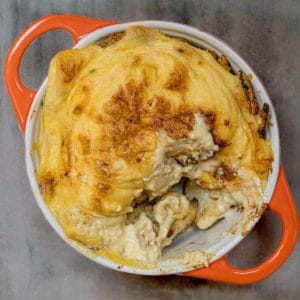Pat macaroni is a Thai dish of pasta sauced with various condiments that include sriracha, soy sauce (I use seasoning sauce) and ketchup. Yes, ketchup. This stir-fry (pat/pad = stir-fried) lacks a strong hit of chilies, unless you make it spicy by preference, so it’s a popular dish for children in Thailand. You might be thinking “but there’s sriracha in,” which would be a valid concern if Thai sriracha was anything like the popularised Huy Fong style condiments, only it isn’t. Good Thai sriracha has a balance of sweet, salty, spicy, and sour, with no flavour elements overwhelming the others; it doesn’t punch you in the face like Rooster brand (which I also love), so for spice sensitive kids it’s a-ok.
But still, ketchup. I’m sure there are some eyerolls and flippant murmurings of “but authenticity!” floating about in some of your minds. Bear with me.
Tomato ketchup, the ubiquitous fast food table condiment, has Roman origins, where it began as a fermented fish-based sauce. Likely introduced to Britain by sailors who returned from Asia with a similar preparation, the English tried to replicate the dark fermented sauce with ingredients like walnuts, mushrooms, various spices, and locally sourceable seafood. Over time, ketchup became the prime flavour component, culminating with Henry J. Heinz, in 1876, producing the formula we know and love today.
Too many people love to hate the sun-ripened tomato puree that is present day tomato ketchup. It seems that most of Britain would like to rip me a new one for insisting on it with roast potatoes. Once I ordered a roast at a popular vegan cafe in Brighton and the waiter literally laughed in my face when I asked for ketchup, as did the English friends I was dining with, and the server never returned with the requested condiment (it was an average meal, and that's being kind).
But I have good reasons, and I can and will defend my love for ketchup to the grave. Tomatoes have a higher content of free glutamate than any other vegetable (okay I know it’s a fruit, but we treat it like a vegetable so for all intents and purposes let’s say it is). The riper the fruit (okay, okay), the more potent is that level of umami, and ketchup utilises very ripe tomatoes. That punch of savouriness combined with salt, vinegar, and sugar creates a well-rounded sauce that calls on all five accepted basic tastes; ketchup delivers sweet, sour, salty, bitter, and umami to our palates in one handy condiment, and that is remarkable.
When people talk about complete meals, they tend to be referencing nutritional values, but to me it’s also about a variety of textures as well as flavours that should ideally complement those five tastes. A Sunday roast doesn’t deliver all of those components, but a tiny dollop of ketchup changes all of that.
If there is one region with a seemingly inbuilt understanding of these balances of flavours in food, it’s Southeast Asia. Of course ketchup is an important ingredient in pat macaroni! Not just because it makes it palatable for young children who aren’t accustomed to fiery spice, but because the condiment helps to make the flavours of the dish line up harmoniously.
Before the recipe, one quick anecdote about Thais and ketchup. A friend from Bangkok once told me the story of taking his mother out to dinner, and this was a relatively recent dining experience, at a newly opened traditional Italian brick oven pizzeria. After her pizza arrived on the table, she immediately looked for ketchup before so much as trying a tiny bite of the pie. When I asked why, my friend laughed "because some Thais associate all Western food with ketchup. To make something Western, we just add ketchup." I guess it's a bit like how people here add coconut milk to a dish and suddenly it's "Thai style."
Vegan Pat Macaroni ผัดมักกะโรนี
This is my interpretation of a popular, mild stir fried pasta in Thailand. Don’t be put off by the idea of ketchup in pasta – I promise it works! In fact, once you taste it, you might prefer it to be a little sweeter, so keep some ketchup or sweet chili sauce to hand. So far as vegetables go the carrots and garlic chives are my preference, but cabbage, peas, and/or spring onions are not unreasonable additions. A few slices of vegan hot dogs are also permissible. Try to use a Thai brand of Sriracha, which is unlike the sauce people commonly associate with sriracha.
- 150 grams macaroni
- 1 tablespoon plus 2 teaspoons ketchup
- 1 tablespoon Thai Sriracha, plus more to season
- 1 tablespoon Golden Mountain seasoning sauce
- ¼ teaspoon sugar
- A couple generous pinches white pepper
- 1 tablespoon extra virgin olive oil
- ½ onion, sliced
- ¼ cup diced carrots
- 3-4 large cloves garlic, chopped
- ½ cup cubed tofu
- ¼ cup 1 inch pieces garlic chives
- 5-6 cherry or baby plum tomatoes, halved
- Cook your macaroni in a pot of salted water until al dente (a minute less than the cooking time on the packet). Drain.
- While the pasta is boiling, combine the ketchup, sriracha, seasoning sauce, sugar, and white pepper in a small bowl.
- Heat a wok to medium heat and add the olive oil, followed by the onion, diced carrots, and garlic. Cook until the onion softens and the garlic begins to brown slightly, 2-3 minutes, stirring often.
- Knock the heat up to medium-high and add the tofu. Mash a few pieces up with the back of your wok spoon or cooking utensil. Toss the garlic chives in and stir fry until bright green and wilted.
- Add the macaroni and the sauce, stirring to coat the noodles evenly. Stir in the tomatoes and cook for another minute or two. Serve immediately.
- Author: Kip Dorrell
- Serves 2
- Cuisine: Thai








Rachel @ GameVillage says
My love for pastas are never dying!! This is a simple and great recipe. Thanks for sharing
kitchens city says
This is one of my favorite dishes. love all your recipes. They are good and easy to make. I will definitely try it.
Kip says
Thanks!
I reserve the right to improve malicious and trollish comments.